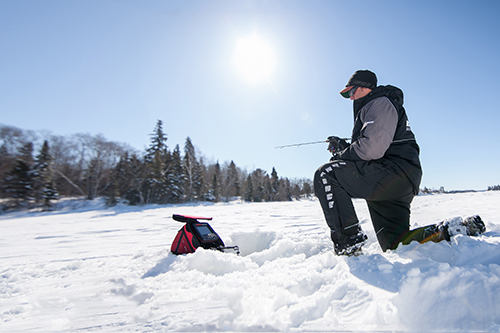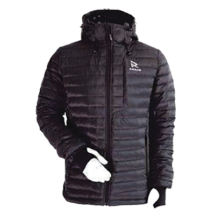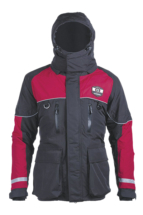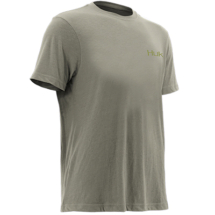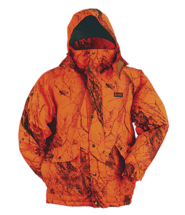By Joe Shead
Contributing Writer
Those of us who love spending time in the outdoors are lucky we live in modern times. Today’s line of winter clothing keeps us warmer and dryer longer, and with less weight and bulk. Plus, outdoor clothing is more specialized than ever. We’ve come a long way from Grandpa’s wool coat and pants and cotton long johns. Staying warm and comfortable in the elements helps us enjoy our favorite outdoor pursuits.
“As the technology advances, the trend is toward less-bulky items,” said Dave Larsen, of Minnesota-based Gamehide.
Warmth with less bulk is an excellent trait for any type of outdoor wear, but it’s especially desirable for an activity such as bowhunting, where you’re quietly trying to draw a bow without being detected. Bulky clothing causes friction and makes it harder to be stealthy.
Larsen said that to retain warmth, clothing still has to have a little bulk.
“There’s got to be a little bulk to it to trap enough air to keep you warm,” he said.
Air pockets in or between the clothing fibers create warmth. Your body generates heat, and these air pockets serve as insulation and a barrier against the cold.
Down – long a staple of outdoor clothing – is still popular, and seems to be making a comeback. Just witness the “puffy” jackets that are trendy these days. Some are made with down – the actually soft, fluffy feathers located under the larger breast feathers of ducks and geese. Some of these jackets are made with synthetic down instead.
Down is perhaps the best insulation known to man. It is also very light – the Mountain Hardware Ghost Whisperer down jacket weighs less than 8 ounces! There are a couple of drawbacks to down, however. First, in order to work properly, it has to have some bulk in order to create heat-retaining air pockets. And second, if it gets wet, the warmth factor goes right out the window. That’s why most down jackets will have some type of waterproofing system to ensure the down doesn’t get wet.
Synthetic down eliminates the wetness factor, but isn’t as warm as the real deal.
Having built-in air pockets is one equation to staying warm. Another factor is blocking the wind. Wind can tear at your clothing, ripping away heat. The outside layer of your clothing determines how much wind gets through.
Laminates added to the outside of your clothing do a good job of blocking the wind and retaining heat. However, they don’t breath as well as fabric with no laminates. They are a good choice for staying warm in cold weather, but they are less desirable in moderate temperatures, or if you’re working up a sweat hauling a deer out of the woods.
Woven fabrics have a tight weave that limits the amount of wind getting through, but still breathes better than a laminate. Larsen said woven fabrics used to have a reputation as being noisy, but they are much quieter these days. Also, the tight weave helps these fabrics resist burrs.
Knit fabrics have a more open weave. They are soft and quiet, but the looser weave allows the wind to get through.
Rain gear is treated with a Durable Water Repellent coating. This coating causes water to bead up and roll off the garment, rather than saturate it.
“Denier” is a term used to describe the strength of the fabric used to make the garment. Adding more denier makes the clothing more resistant to abrasion. Larsen said waterfowl jackets are made of high-denier material to withstand ice, brush, cattails and the like. This makes the material tough, but noisier than would be desirable for bowhunting.
With clothing, it’s always about trade-offs. If you want to block the wind, rain, burrs and briars, the clothing is going to be a bit on the noisy side. If you want the softness and quietness of fleece, you’re going to sacrifice some wind resistance, and ultimately, warmth. Fleece picks up more briars than a tighter-knit fabric or one with laminates. But clothing manufacturers have done a good job of leveling the playing field a bit, making the noisy fabrics less so and the soft fabrics more wind-resistant. The Gamehide Deerhunter Parka is a perfect example. Its Hunter Hide fabric is tough enough to resist burrs and briars, yet soft enough and quiet enough to hunt without spooking game.
Layering has always been an important concept when dressing for the outdoors. Adding more layers not only keeps you warm, but each layer can serve a purpose, as well. For example, you might wear a moisture-wicking layer against your skin to keep you from getting cold during physical exertion. Next, you might add a layer or two of soft, warm material that traps a lot of air for insulation. You could then finish off with a high-denier parka to keep the wind at bay.
But Larsen said layering complicates things.
“We’re finding the consumers want to simplify it. They want to just grab their jacket and go.”
That means clothing manufacturers have their work cut out for them to try to build in as many of these properties as possible, all into one package.
Larsen said, for example, a hunter who has a short walk to his stand doesn’t want to be burdened with putting on several layers. He just wants to throw on a coat and hunt.
As a result, clothing manufacturers are trying to add all the elements together, allowing fabric to breath so hunters don’t get overheated on the walk to their stand, while still keeping them warm and protected from the wind. It’s a tall order, but increasingly, manufacturers are rising to the challenge.
Another interesting phenomenon is the specialization of clothing. Just think of fishing. In the old days, you just threw on any old fishing shirt and your favorite fishing hat and you were all set for a day on the water. But nowadays, even summer fishing – an activity in which you wouldn’t normally give much thought to your clothing choices – has entered the specialty clothing market. A good example is Huk Gear. This clothing line has really caught on in just a short time. A product such as the Huk KC Scott Tee is more than just a T-shirt. The material allows your body to cool naturally in hot weather, but without dehydrating you. The company’s products protect you from the sun and wind, while being breathable, quick-drying and incorporating anti-microbial components to the fabric, to keep you from sweating and reduce odors even if you do. A lot of thought has gone into these designs, and customers are taking notice.
Summer anglers aren’t the only ones to benefit from advances in clothing. Ice fishing parkas and bibs get better every year. These garments are made from materials that block the wind and protect you from snow and ice, but increasingly more of these suits have built-in flotation, should the unthinkable happen. The Ice Armor Ascent Float Parka and the Striker Climate Jacket incorporate material that provides flotation. They are not U.S. Coast Guard-licensed PFDs, but are designed to keep the wearer afloat.
If you’re one of those people who is always cold, you might consider battery-operated clothing. The Ravean Men’s Down Heated Jacket runs on a lithium-ion battery. It has various heated areas that can be controlled independently and placed on different settings to warm you as needed. It even has an accessory port to charge your phone.
Outdoor clothing just keeps getting better and better. It’s lighter, quieter and less bulky than ever before. These improvements help us stay afield longer and enhance the joy of our outdoor pursuits.

